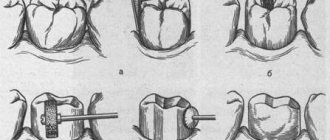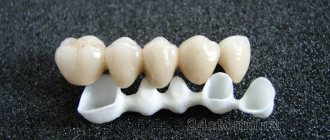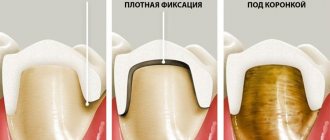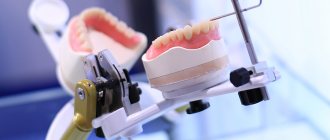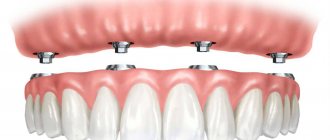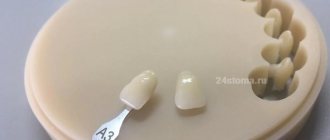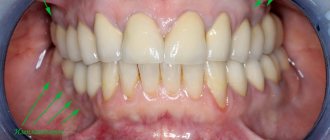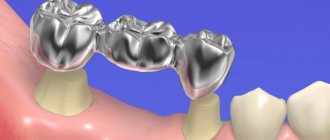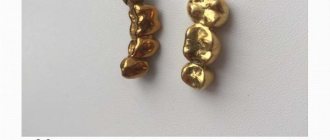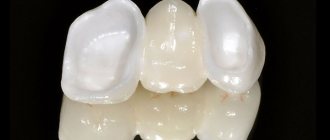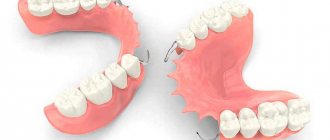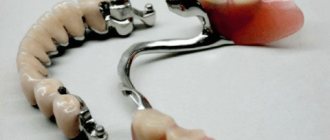There are several types of crowns designed to be a functional and aesthetic replacement for a missing part of a tooth. Among them, such types as stamped and solid metal crowns are widely known. Previously, stamped crowns were used everywhere. During the Soviet Union, prosthetics were carried out in just such an inexpensive and very simple way. However, over the years, stamped crowns have lost popularity, giving way to solid crowns. Why did this happen?
What is a stamped metal crown?
Externally, the thin-walled structure resembles the shape of an incisor or molar
A stamped metal crown is an orthopedic prosthesis used in the dental industry to restore dentition.
Externally, the thin-walled structure resembles the shape of an incisor or molar.
This type of prosthetics is used when the root is preserved, and the indication is to partially restore the functionality of the tooth and prevent its further destruction.
The technology for making a prosthesis is the simplest: a shape is tapped from a blank-sleeve that is as close as possible to the impression made on the patient’s jaw.
The thickness of the crown wall depends on the metal used in the manufacturing process of the product. The average value is 0.2-0.3 mm, which determines the parameters for grinding the tooth.
A Brief History of Dental Crowns
People began to treat and restore teeth since ancient times. During excavations of settlements of different nationalities, archaeologists found dental crowns and bridges that our ancestors made long before the beginning of our era.
Pierre Fauchard is considered to be one of the fathers of modern orthodontics. A French dentist made gold caps for his patients' teeth and covered them with a thin layer of porcelain, which quite accurately imitated the color of tooth enamel. And already in 1873, a doctor from California, John Beers, received the first patent for a gold crown. In 1885, an even more epoch-making invention was patented - Logan's porcelain crown on a metal (platinum) pin, which in an improved version was used for a very long time.
More noticeable progress in the manufacture of modern dental crowns began in the last century, when in 1929 two colleagues Raiborn-Kjennerud and Häupl presented to the scientific world their work - a dental crown, which was made according to the principle of a nesting doll. This was the first telescopic crown system in which an internal frame was cemented onto a partially decayed tooth and an external crown was placed on top of it.
In the late 30s, a dentist from the United States, Charles Pincus, invented and began installing veneers for film actors - snow-white microprostheses that were attached to the outer part of the tooth. True, the dentures were short-lived and fell off after a while. But it was then that the term “Hollywood smile” appeared, which became the motto of aesthetic dentistry.
By the middle of the 20th century, dental crowns were already being manufactured and actively used throughout the world. They were made mainly from various metals: steel, an alloy of gold with silver and copper, pure gold. To reduce the cost of crowns, but at the same time give them a “noble” appearance, yellow plating (gold or titanium nitride) was often applied to the steel. Such teeth were fashionable for a long time; they were installed not only on chewing teeth, but also on fangs and incisors.
Metal crowns were made in the last century by stamping and casting, and bridge structures were soldered. All of them had certain drawbacks in terms of aesthetics, but were quite durable.
Metal-plastic crowns (consisting of a metal frame with a plastic coating) were much more aesthetically pleasing. But the plastic absorbed odors and changed color over time because it reacted with pigments from food. Despite this, this type of prosthetics is still used. True, only as a temporary structure.
Clinical and laboratory stages of manufacturing
The process of making crowns requires adherence to certain principles to ensure high-quality installation and minimal likelihood of complications:
- Trying on a finished crown
The orthopedic structure must at least partially perform the function of a tooth.
- There should not be large gaps when the crown touches the neck of the tooth. A small gap is filled with cement, but during wear it gradually collapses. A large gap will cause a number of problems, but a small space is considered normal.
- The prosthesis is fixed in such a way that the metal surface does not sink into the gum groove by more than 0.3 mm. Exceeding this indicator causes the development of marginal periodontal disease.
- When installing a metal structure, it is necessary to maintain the interalveolar interval in relation to the adjacent tooth. Otherwise, injury to a healthy unit or soft tissue may occur.
- The shape of the prosthesis should be close to the anatomical one so that the appearance of a number of teeth is not disturbed and there is no discomfort when wearing the product.
The production of an orthopedic structure includes clinical and laboratory work.
The clinical stages are carried out by an orthopedist in the following sequence:
- The specialist grinds the tooth and creates a stump.
- The choice of color and type of material is made together with the patient.
- Taking impressions from the jaw where the prosthesis is planned to be installed.
- Transferring data to the laboratory technician, where the prosthesis is manufactured.
- Fitting and correction of orthopedic construction.
- Fixing the product with cement mortar.
Laboratory work is carried out by a dental technician.
The stamping technology is as follows:
- Modeling a prosthesis using an impression.
- Obtaining a plaster model.
- To identify the correct ratio of units in the dentition, the model is fixed in the occluder, giving it the position of central occlusion.
- The model is covered with wax and a crown is modeled.
- Making a stamp from a gypsum composition.
- Selection of a suitable sleeve (size, color).
- Stamping of light alloy crowns.
- Transfer the product to the orthopedist for fitting.
- If necessary, perform correction, as well as final grinding and polishing.
How are dentures made?
- Therapeutic treatment of the tooth is carried out after its preparation.
- An impression of both jaws is made using plaster or alginate. Plaster impressions are gradually becoming a thing of the past as obsolete; the use of alginate is preferable.
After this, the dentist begins to work closely in the dental laboratory.
- He is given a model of the dentition of both jaws cast in plaster, on which, in case of problems with the bite, the central relationship for its correction is determined.
- Plaster of Paris is placed in the occluder.
- A plaster stamp is cut out of the wax model that is then created, and then a metal one is made according to its sample.
- The sleeve-blank is selected as precisely as possible according to the size of the cast die.
The fact is that the sleeves are produced according to average parameters, and in order to fit the prepared stamp exactly to the tooth stump, there are two ways: choose the exact size or reduce it from the available ones. The sleeve is put on the second die and the fitting work begins, which includes thermal and mechanical effects on the workpiece.
The final check of the finished crown is done in the clinic, where, after fitting, they look at how tightly it fits (without taking into account the future cement layer) to the neck of the tooth. Defects are identified, then the outer surface is ground. If the patient expresses a desire, titanium nitride will be sprayed onto the steel surface.
At the last stage, the finished crown is dried using alcohol treatment, the cement is diluted and injected inside, and it is forcefully pressed onto the tooth stump. To do this, you just need to clench your jaw tightly. The squeezed out excess cement is removed.
Kinds
There are several types of metal structures:
- Dentures are installed in the presence of a destroyed tooth fragment, when it is not possible to install a filling or inlay
Stamped - made on the basis of caps (sleeves) with subsequent giving the workpiece the anatomical shape of the patient’s tooth;
- Cast - the manufacturing process includes casting molten metal into a prepared mold, this makes it possible to obtain precise parameters of the prosthesis and a high-strength product;
- Brazed - the manufacturing technology resembles a stamped one, but the sleeve is first cut into 2-3 parts, after tapping it is joined together by soldering (this method is used in cases where it is not possible to give an anatomical shape to the whole sleeve).
Comparative characteristics of artificial crowns
| Variety | Positive traits | Negative qualities |
| Metal (stamped and cast); | Stamped – gentle preparation (only the most protruding part of the crown around the circumference is ground); | Cast – hardness and bioinertness of noble alloys (does not interact with the body). |
| Combined (metal-ceramics) |
|
|
| Plastic and composite (currently used only as temporary) |
|
|
| Metal-free (ceramic and zirconium dioxide-based) |
| The relative fragility of pressed ceramics (IPS Emax technology, used only in the anterior part of the dental arches) |
Date of publication: September 20, 2020 Last update: September 22, 2021 © 2020 Professorial Dentistry “22 Century”. All rights reserved.
Installation of stamped metal crowns
Fixation of crowns is carried out only after treatment of identified dental diseases. The prosthetic process involves tooth preparation, but the layer of bone tissue removed is minimal compared to other methods of restoring the dentition.
Preparatory work is carried out in the following sequence:
- Removing the top layer of enamel (0.3 mm). The work is performed with a special diamond disc.
- After preparation, the orthopedist checks the gaps between the causative and contacting teeth. The interval should correspond to the thickness of the crown. Control is carried out using a wax sheet.
- The next step is to prepare all contact surfaces (adjustment to the thickness of the crown).
- The process is completed by preparing the oral and vestibular parts of the tooth in order to give the stump a cylindrical shape. The diameters of the stump and neck of the tooth must be the same.
Installation of a crown made of stamped metal is carried out in the following order:
- examination by a doctor of the oral cavity to ensure the absence of inflammatory processes;
- quality control of preparatory work;
- fixing the crown to the stump by applying cement to the joint.
Upon completion of prosthetics, the doctor gives recommendations to the patient on caring for the oral cavity and, in particular, the crown.
Stages of crown installation
Preparing a tooth for prosthetics
- In order for the crown to sit firmly on the tooth, it must first be ground, removing a thin layer of enamel. Usually the doctor removes about 0.5 mm. It may be necessary to remove a thicker layer. This depends on the material from which the prosthesis will be made. If gold is used, then you will have to grind more, because in this case gold solder will need to be poured onto the inside of the structure. This will significantly increase the service life of the crown.
- Now the doctor needs to check the gap between the tooth being prepared and its antagonist. To do this, the patient bites on a special wax strip, and the doctor checks the resulting imprint.
- Using diamond separating discs and shaped heads, the dentist processes the proximal surfaces.
Before installing a crown, additional preparation is necessary to ensure that the crown sits firmly on the tooth. The required tooth is first wrapped and a thin layer of enamel is removed. - After this, all that remains is to process the buccal and palatal surfaces and create a stump in the form of a cylinder. The diameter of the stump should be equal to the diameter of the tooth neck. This is the only way the prosthesis can fit well onto the tooth. If you violate the proportions, the structure will not fit tightly.
Advantages and disadvantages
When choosing the type of crown, it is necessary to compare the existing positive qualities, properties of the material and its disadvantages.
This will relieve discomfort and disappointment in the process of wearing an orthopedic design:
| Characteristics of a stamped metal crown | |
| pros | Minuses |
| Simple technology for making a crown. | Over time, the cement on which the structure sits deteriorates. This leads to the formation of gaps between the dentin and the prosthesis. |
| Possibility of using the structure without preliminary depulping. | The layer of stamped metal is insignificant, so while the crown is worn, its surfaces wear out. |
| The duration of the treatment process does not take much time. | This type of prosthetics does not restore the functionality of the tooth due to the inability to recreate the anatomical shape of a molar or incisor. |
| Low installation requirements, which allows the use of a stamped design even in cases where another type of prosthetics is contraindicated for a number of reasons. | Dentures made of stamped metal do not provide a tight fit to soft tissues, which provokes the penetration of food particles under the structure, where a favorable environment for caries and other diseases develops. |
| During the process of prosthetics, dental tissue is ground, but a minimal layer is removed (0.3 mm). | The aesthetic side of metal products leaves much to be desired. Such a jaw is unlikely to decorate a smile. |
| The use of a stamped metal product is the most affordable type of prosthetics. | |
There are plenty of pros and cons of a stamped prosthesis, but during the analysis it becomes clear that this type, due to its accessibility and simplicity of manufacturing technology, has the right to exist.
In what cases does a tooth need a crown?
Indications for the use of a crown can be for a variety of reasons:
- Elimination of tooth defects at the crown part, where it is impossible to place a filling or onlay
- Preserving a tooth from destruction
- Protection of a healthy tooth on which a prosthesis will be placed or to which a bridge will be attached
Unlike a porcelain crown, which looks much more aesthetically pleasing, a metal crown is thin. Therefore, its installation does not require extensive cutting of the tooth. It is this circumstance that makes it possible to use stamped crowns to protect healthy teeth.
If you have a problem similar to that described in this article, be sure to contact our specialists. Don't diagnose yourself!
Why you should call us now:
- We will answer all your questions in 3 minutes
- Free consultation
- The average work experience of doctors is 12 years
- Convenient location of clinics
Single contact phone number: +7
Make an appointment
Price
Prices for stamped dentures vary depending on the regional location of the clinic and the presence/absence of a sprayed layer
A wide selection of modern materials is gradually replacing the installation of stamped crowns from the list of services of some clinics.
But the presence of an interested segment of consumers still hinders the final refusal to use this material in prosthetics.
Prices for stamped dentures differ depending on the regional location of the clinic and the presence/absence of a sprayed layer.
The cost of a regular crown is 1,500 rubles. You will have to pay a little more for a product with spraying (1,700 rubles). In the case of making a crown with plastic lining, the price will increase to 2000 rubles.
Solid crowns
Modern casting methods have made it possible to produce high-quality thin-walled crowns. A solid crown is used to restore the shape of a damaged tooth, its preservation, as a support for bridges and removable dentures. It is cast from a cobalt-chrome alloy, resulting in a solid product without solders. Even when creating bridge-like prostheses, soldering of elements is not required; the structure is poured out entirely. Such crowns can have various manufacturing options.
- Regular crown without coating, polished metal.
- Gold-plated crown. May cause allergic reactions. When worn for a long time, the coating wears off.
- Solid plastic crowns. They have a cast metal frame and a plastic onlay to give the aesthetic appearance of natural teeth. If worn for a long time or carelessly, the plastic may chip.
- Metal ceramics. The most expensive type of crowns, they have durability and a natural appearance.
Indications for the use of cast crowns:
- Significant damage to teeth.
- Pathology of the shape of the teeth or its location.
- Malocclusion.
- Anomaly in tooth size.
- Support for removable and bridge dentures.
- Prevention of tooth abrasion, bruxism.
Features of care
Special care for crowns made from stamped metal is not required. The main measures include regular hygiene procedures and thorough cleaning of the oral cavity after eating food.
The list of recommended products includes:
- paste and brush with medium-hard bristles;
- rinse balm;
- dental floss.
After smoking cigarettes or drinking coffee, you need to rinse your mouth with a special liquid; in extreme cases, you can get by with water.
Every six months you need to visit the dental clinic to monitor the integrity of the prosthesis and for thorough cleaning of the oral cavity, which can only be provided by professional cleaning.
Such measures will help prevent the formation of plaque and the growth of stones. Also, based on a number of signs, a specialist can promptly identify the problem and prescribe treatment.
Possible errors and ways to fix them
In order for the prosthesis to fit the patient perfectly, it is necessary to strictly adhere to technology during its manufacture. But even in this case, errors are possible that will require correction.
- If during the installation of the crown the edge of the gum begins to turn pale, the structure needs to be shortened slightly using a bur and scissors.
- If the stump is too large in diameter, the doctor will need to sharpen the tooth so that the crown fits tightly on it.
- If the prosthesis is made poorly, the doctor sends it to the laboratory for revision.
- If the crown is too short, it cannot be used. It also cannot be corrected. In this case, it is necessary to make a new design that will suit the patient in all respects.
During the installation of the crown, it is possible to adjust the product for the best contact. If the crown is not made correctly, it is sent to the laboratory for revision.
Durability
Experts recommend not to wait for complications to arise and to consult a doctor promptly.
The metal alloy stamping is quite thin, so during the operation of the crown it wears out quickly.
The surface, which is often in contact with other teeth, is subject to abrasion.
This explains the short service life, which is indicated by 3-5 years.
Fragility is due to other factors:
- the presence of a gap between the structure and dentin, which provokes the development of caries and other dental problems;
- crown deformation as a result of eating hard foods.
Experts recommend not waiting for complications caused by the above reasons to occur.
Every 2-3 years, crowns simply need to be replaced with new ones, even if the old ones have not yet lost their aesthetic appearance. It is difficult to assess the condition of dentin under the structure, so there is a need for revision.
What is more important: crown material or technology?
Of course, the material plays a huge role. The aesthetics, wearing comfort, and durability of the crown depend on it. But manufacturing technology is no less important. For example, now a fundamentally new set of equipment, materials and technologies CEREC has appeared - a fully computerized system that in 2-3 hours takes a digital 3D image, models a crown on a computer and manufactures it using ceramic milling. This is the technology of the future, in which error due to the human factor is excluded.
How to properly care for such crowns
As mentioned above, this type of orthopedic structures is characterized by a number of operational disadvantages. Therefore, such products require more careful care and hygiene. Here are some basic recommendations from experts in this regard:
- do not forget to thoroughly clean your teeth and tongue twice a day with a brush and paste,
- rinse your mouth every time after eating,
- use floss threads for better cleaning of interdental spaces.
To prolong the life of the crown, proper dental hygiene is important.
About 3 months after prosthetics, you should visit your dentist so that he can evaluate how successful the treatment was. With stamped crowns in the mouth, it is recommended to undergo preventive examinations more often than usual - once every 3 months.
What materials are used to create the product?
Such crowns are created from special steel or gold, but the latter option is rarely used today, since the material is quite expensive. In general, the stamping method is outdated, so it is currently used only in rare cases.
So, to create such products one of the following types of steel can be used:
- stainless steel – characterized by increased malleability and a sufficient degree of ductility,
- alloy 1Х18Н9Т – a budget option, characterized by relative lightness.
To create crowns, two types of materials are used.
In this case, steel structures can be coated or without it. In the latter case, the product turns out to be shiny and silver in color. Titanium nitride is usually used as a coating material, which gives the crown a golden color. If we talk about gold structures, then 900 ductile gold with additional 750 karat solder is used to create them.
